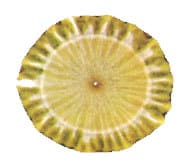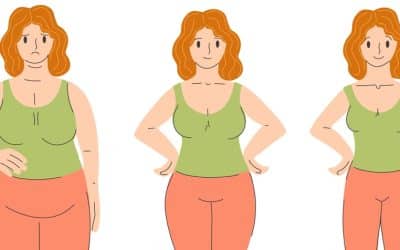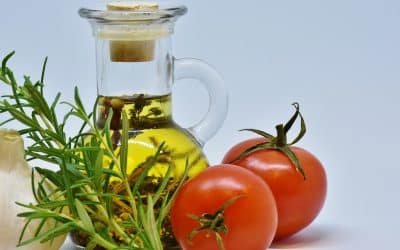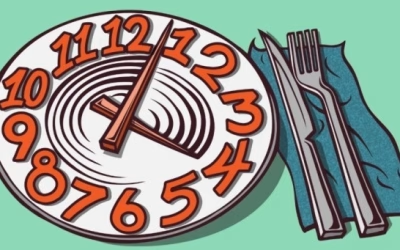Chromatograms of Natural vs Synthetic Products
What Is a Chromatogram?
Chromatograms have been used in urine tests for quite some time. Ehrenfried E. Pfeiffer, M.D., perfected it to graphically show that even though soil sample may have the same chemical makeup, they differed in their biological values (yield, protein quality, seed germination, etc.). This breakthrough explained why some soils yielded better crops than others.
This same technique can be used to differentiate between two foods or two vitamins, they may look the same chemically but often times they do not look the same biologically or qualitatively.
The technique is similar to taking a urine analysis with test strips. The juice –an extract is made– of a certain substance is placed on specially manufactured filter paper and by using a chemical agent an image is displayed. The image, through difference in colors, rings, spike like forms, etc. can than be interpreted to determine its qualitative and biological values.
How Can We Use Chromatograms In Nutrition?
In Nature, every living thing has a purpose but also a very distinct pattern in a chromatogram. You can see the biological activity of an organic substance on the chromatogram. The fresher the substance the greater the activity and the more prominent the enzyme formations are. Most inorganic mineral, chemical or synthetic vitamins show only varied colored rings with no distinct patterns because they are not alive.
The following chromatograms illustrate the very distinct differences between natural and synthetic vitamins and some common food items.
These chromatograms show that Nature does something that cannot be duplicated by man. Even when the chemical analysis is identical, you can easily see that in the synthetic version, there is definitely something missing.
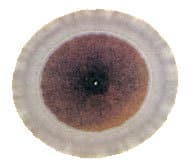
|
|
|
|
1b. Acerola–tropical cherry natural Vitamin C |
||
|
Typical color and rings of ascorbic acid — no |
Jagged border and strong radiations, indicative of natural factors and vitamin and mineral activity. |
|
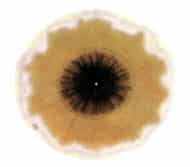
|
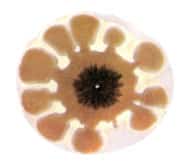
|
|
|
2a. Alpha – tocopherol commercial Vitamin E only a part of complete E complex.
|
2b. Wheat Germ Oil unheated — excellent source of Vitamin E
|
|
|
Intrinsic factors cannot show up because of refined state.
|
In addition to Alpha-Tocopherol other fatty acids and enzymes indicated — note similarity to butter.
|
|

|
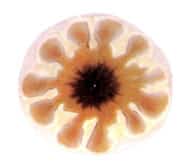
|
|
|
3a. Synthetic Vitamin A made from refined and chemically altered lemon grass root.
|
3b. Cod Liver Oil — excellent source of Vit. A & D.
|
|
|
We miss here the winged or leaf pattern which shows up in natural products.
|
Note wings or leaf pattern found in all natural oils or fats as butter and wheat germ oil above.
|
|
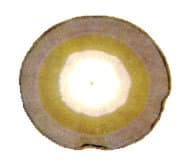
|
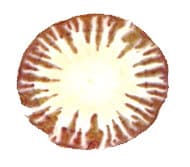
|
|
|
4a.Complete synthetic Vitamin B complex — mixture of known parts.
|
4b. Natural ‘B’ complex
|
|
|
No spike like enzyme formations
|
Thin outer rim, long jagged teeth indicate intrinsic factors, good protein & strong enzyme activity.
|
|
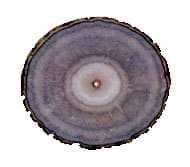
|
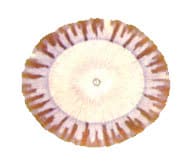
|
|
|
5a. Mixture of synthetic vitamins & inorganic
minerals. |
5b. Mixture of natural vitamins and minerals of the “vitamins and minerals” chemically reproduced in 5a.
|
|
|
Utterly lacking in biological intrinsic factors or any spike enzyme formation.
|
Center radiation & jagged spike formations show excellent intrinsic factors, vitamin & enzyme activity.
|
|
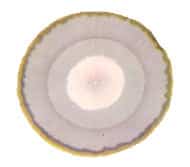
|
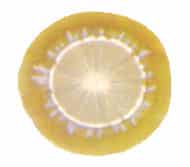
|
|
|
6a.A popular soft drink
|
6b. Fresh orange juice organically grown.
|
|
|
Outer edge shows the sugar
|
Outer zone indicates presence of enzymes & Vitamin C, also color of inner circle shows more Vitamin C.
|
|
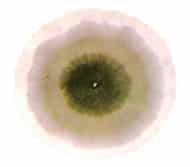
|
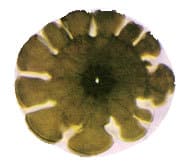
|
|
|
7a. Margarine
|
7b. Butter, fresh home-made from un pasteurized milk
|
|
|
Lacks vitamin & enzyme formation — its value best judged by comparison with Butter 9b.”
|
See the winged pattern and color of many intrinsic factors and vitamin influences
|
|
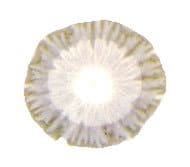
|
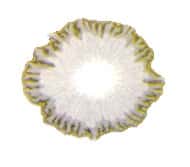
|
|
|
8a. Pasteurized milk
|
8b. Raw milk-whole
|
|
|
Paler, less definite formations than 8b indicating some
loss of factors. |
Pattern of outer edge & protrusions from edge to center indicate proteins, vitamins & minerals.
|
|
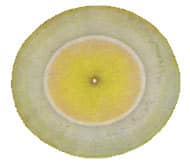
|
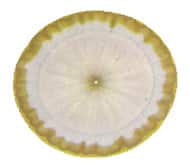
|
|
|
9a. Synthetic sugar – glucose (dextrose) mostly used in presweetened foods
|
9b. Molasses-old fashioned
|
|
|
Corn sugar chemically refined — brown color shows sugar reaction — yellow shows some other reaction.
|
More vitamins indicated by wider more undulating outer zone & slight radiating inner field.
|
|
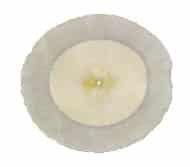
|
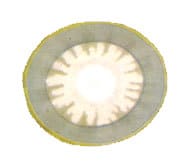
|
|
|
10a. White flour – bleached
|
10b. Whole unbleached flour-organically grown
|
|
|
Little is left of original quality of the wheat seeds. Vitamin and enzyme formations lacking.
|
Contains intrinsic factors, vitamins & enzymes of the germ — spikes of inner circle indicate enzymes.
|
Source from Dr. Ehrenfried E. Pfeiffer, Biochemical Research Laboratory, Spring Valley, New York
Further information on natural healthcare
Lose The Weight
[dsm_button button_one_text="Free Analysis" button_one_url="https://alternativehealthatlanta.com/health-test/" button_two_text="Become a Patient" button_two_url="https://alternativehealthatlanta.com/schedule-complete-health-analysis-2/" button_alignment="center"...
Are You Healthy? A Conclusive Answer
[dsm_button button_one_text="Free Analysis" button_one_url="https://alternativehealthatlanta.com/health-test/" button_two_text="Become a Patient" button_two_url="https://alternativehealthatlanta.com/schedule-complete-health-analysis-2/" button_alignment="center"...
Cause of Chronic Disease
[dsm_button button_one_text="Free Consultation" button_one_url="https://alternativehealthatlanta.com/health-test/" button_two_text="Become a Patient" button_two_url="https://alternativehealthatlanta.com/schedule-complete-health-analysis-2/" button_alignment="center"...
Exercise Should Be Fun
[dsm_button button_one_text="Free Analysis" button_one_url="https://alternativehealthatlanta.com/health-test/" button_two_text="Become a Patient" button_two_url="https://alternativehealthatlanta.com/schedule-complete-health-analysis-2/" button_alignment="center"...
What are the Causes for Women’s Health Issues?
[dsm_button button_one_text="Free Analysis" button_one_url="https://alternativehealthatlanta.com/health-test/" button_two_text="Become a Patient" button_two_url="https://alternativehealthatlanta.com/schedule-complete-health-analysis-2/" button_alignment="center"...
Is Your Thinking “Broken?”
[dsm_button button_one_text="Free Analysis" button_one_url="https://alternativehealthatlanta.com/health-test/" button_two_text="Become a Patient" button_two_url="https://alternativehealthatlanta.com/schedule-complete-health-analysis-2/" button_alignment="center"...
Grounding— A Simple, Pleasurable Way to Reduce Inflammation and Chronic Disease
[dsm_button button_one_text="Free Analysis" button_one_url="https://alternativehealthatlanta.com/health-test/" button_two_text="Become a Patient" button_two_url="https://alternativehealthatlanta.com/schedule-complete-health-analysis-2/" button_alignment="center"...
Amazing Olive Oil Benefits, How to Spot Fake Olive Oil
[dsm_button button_one_text="Free Analysis" button_one_url="https://alternativehealthatlanta.com/health-test/" button_two_text="Become a Patient" button_two_url="https://alternativehealthatlanta.com/schedule-complete-health-analysis-2/" button_alignment="center"...
Allergies Don’t Have to be a Forever Problem
[dsm_button button_one_text="Free Analysis" button_one_url="https://alternativehealthatlanta.com/health-test/" button_two_text="Become a Patient" button_two_url="https://alternativehealthatlanta.com/schedule-complete-health-analysis-2/" button_alignment="center"...
Would Intermittent Fasting Work for You?
[dsm_button button_one_text="Free Analysis" button_one_url="https://alternativehealthatlanta.com/health-test/" button_two_text="Become a Patient" button_two_url="https://alternativehealthatlanta.com/schedule-complete-health-analysis-2/" button_alignment="center"...

